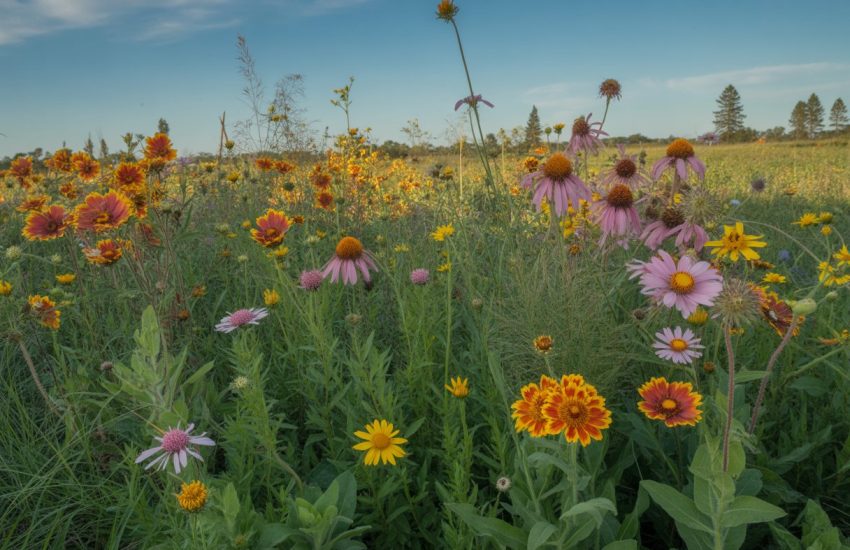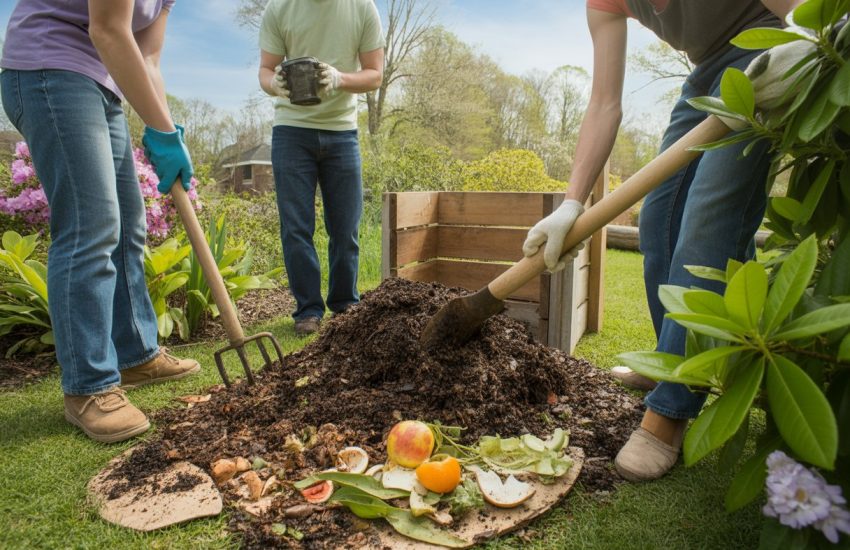How to Keep Poinsettias Alive: Tips and Tricks
Poinsettias are a popular choice of houseplant during the Christmas season. With their bright red and green foliage, they add a festive touch to any home. However, many people struggle to keep their poinsettias alive beyond the holiday season. In this article, we will provide you with expert tips on how to care for your poinsettia and keep it thriving throughout the year.
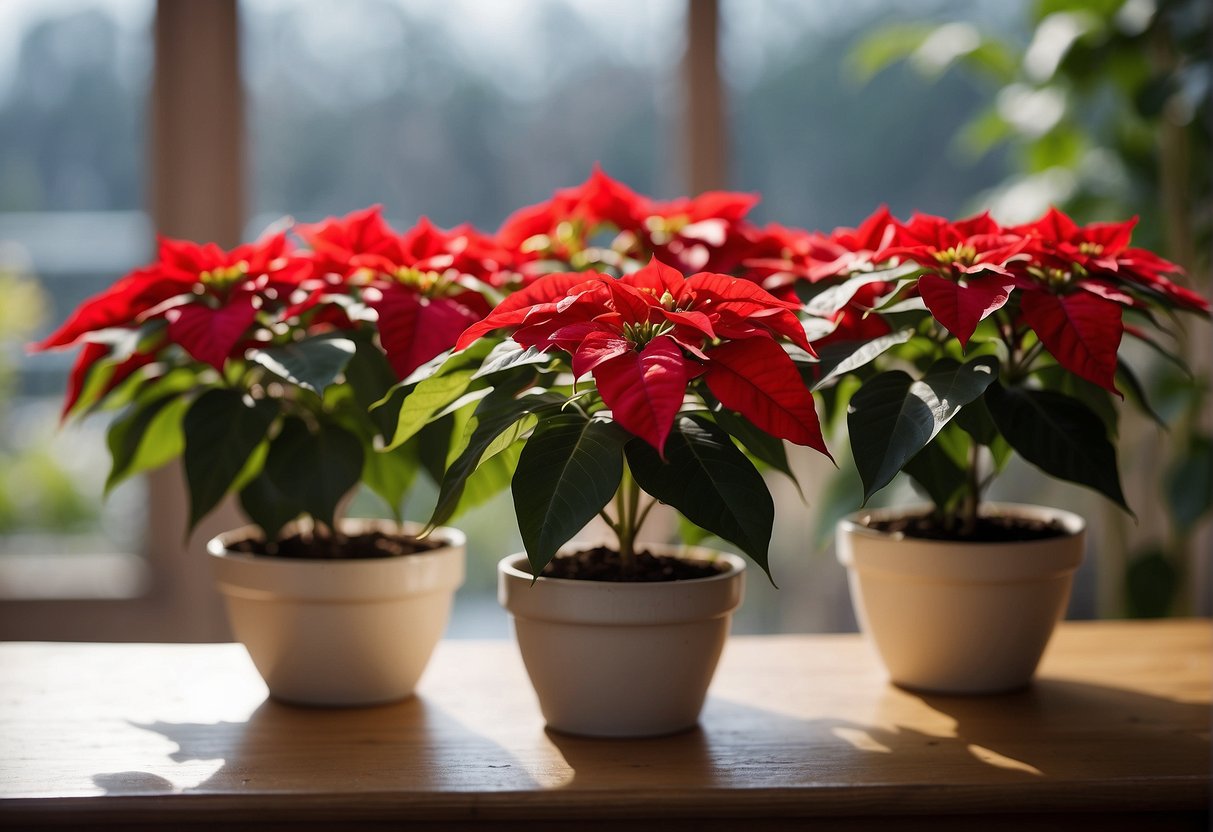
First and foremost, it is important to understand the basic care requirements of a poinsettia. These plants prefer a warm and humid environment with plenty of bright, indirect sunlight. They also require regular watering, but it is important not to overwater them as this can lead to root rot. Additionally, poinsettias are sensitive to temperature changes, so it is best to keep them away from drafty windows or doors.
To ensure your poinsettia stays healthy, it is crucial to provide it with the right nutrients. Fertilizing your plant every two to three weeks with a balanced, water-soluble fertilizer can help promote healthy growth and vibrant foliage. Additionally, removing any dead or yellowing leaves can help prevent the spread of disease and keep your plant looking its best. By following these simple tips, you can enjoy your poinsettia well beyond the holiday season.
Selecting the Right Poinsettia
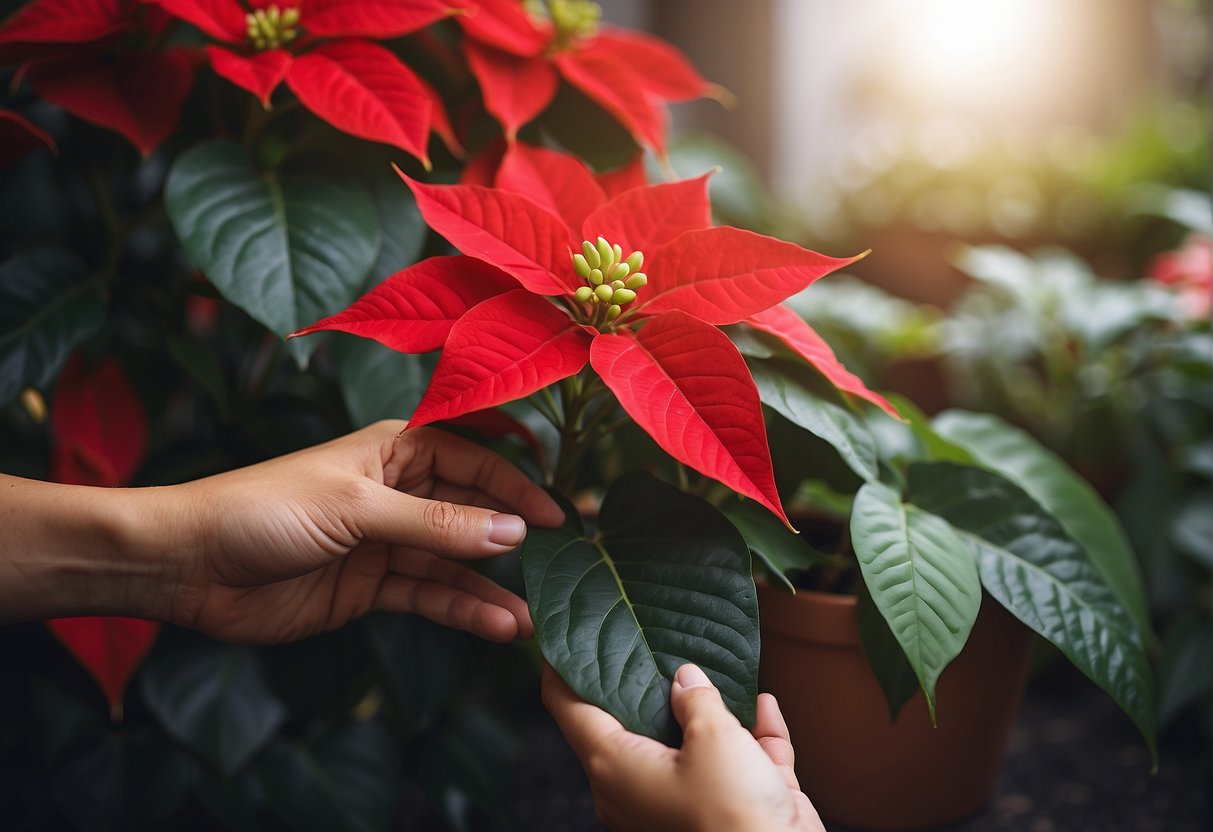
When it comes to selecting a poinsettia, there are a few things to keep in mind to ensure that you choose a healthy plant that will thrive in your home. This section will cover two important considerations when selecting a poinsettia: assessing plant health and understanding poinsettia varieties.
Assessing Plant Health
When selecting a poinsettia, it’s important to choose a plant that is healthy and free from pests or disease. Here are a few things to look for when assessing plant health:
- Fullness: Choose a plant that is full and bushy with plenty of leaves and bracts. Avoid plants that have bare spots or look sparse.
- Color: Look for plants with vibrant, colorful bracts. Red is the most common color, but poinsettias also come in white, pink, cream, purple, and burgundy. Choose a plant with bracts that are evenly colored and free from blemishes or discoloration.
- Leaves: Check the leaves for signs of damage or discoloration. Healthy leaves should be green and free from spots or yellowing.
- Stems: Inspect the stems for signs of damage or weakness. A healthy poinsettia should have strong, sturdy stems that can support the weight of the bracts.
Understanding Poinsettia Varieties
Poinsettias come in a variety of shapes and sizes, so it’s important to choose a variety that will work well in your home. Here are a few popular poinsettia varieties:
- Traditional: The traditional poinsettia has bright red bracts and dark green leaves. This variety is the most common and is widely available at supermarkets and garden centers.
- Marbled: Marbled poinsettias have variegated bracts with patterns of red and white. These plants are a bit more unusual and can add a unique touch to your holiday decor.
- Jingle Bells: Jingle Bells poinsettias have curled, ruffled bracts that resemble bells. This variety is a bit more delicate than traditional poinsettias and may require a bit more care.
- Ice Punch: Ice Punch poinsettias have bright pink bracts with a white center. This variety is a bit more unusual and can add a pop of color to your holiday decor.
By keeping these tips in mind, you can choose a healthy, beautiful poinsettia that will brighten up your home during the holiday season.
Essential Care Guidelines
Watering Techniques
Poinsettias require moderate watering. Overwatering can lead to root rot, while under-watering can cause the leaves to wilt and fall off. It is important to water the plant thoroughly and let the soil dry out slightly before watering again. To prevent water from accumulating at the bottom of the pot, ensure that the pot has proper drainage holes.
Light and Temperature Requirements
Poinsettias need indirect light to thrive. Direct sunlight can scorch the leaves and cause the plant to wilt. They also require a temperature range of 60-70°F during the day and 55-60°F at night. Exposure to extreme temperatures can cause the leaves to drop.
Soil and Fertilization
Poinsettias prefer well-draining potting soil with a slightly acidic pH. It is recommended to fertilize the plant once a month during the growing season with a balanced fertilizer. Over-fertilization can lead to excessive growth and poor blooming.
Remember to keep the soil moist but not waterlogged. It is important to avoid overwatering, as it can lead to root rot.
Following these essential care guidelines can help keep your poinsettia healthy and vibrant throughout the holiday season.
Maintaining Poinsettias Year-Round
Poinsettias are popular holiday plants known for their vibrant red and green foliage. However, with proper care, they can be enjoyed year-round. Here are some tips for maintaining poinsettias throughout the year.
Pruning and Repotting
Regular pruning and repotting can help keep poinsettias healthy and encourage growth. Prune your plant in the early spring to promote bushier growth and remove any dead or damaged leaves. Repot your poinsettia every two to three years to ensure it has enough space to grow and access to fresh soil.
When repotting, choose a container that is slightly larger than the current one and use a well-draining potting mix. Poinsettias prefer slightly acidic soil with a pH between 5.5 and 6.5. Water your poinsettia thoroughly after repotting and allow the soil to dry out slightly before watering again.
Encouraging Reblooming
Poinsettias require specific conditions to rebloom, including a period of darkness and a specific light cycle. To encourage reblooming, follow these steps:
- Starting in early October, expose your poinsettia to complete darkness for 14 to 16 hours each day. Cover the plant with a box or place it in a closet to ensure it is in complete darkness.
- During the remaining 8 to 10 hours of the day, place the plant in a sunny location with indirect light.
- Continue this light cycle for six to eight weeks, until flower buds begin to form.
- After the blooming period, allow your poinsettia to enter its natural growth cycle by providing it with regular light and water.
By following these tips, you can keep your poinsettia healthy and encourage it to rebloom year after year.
Troubleshooting Common Problems
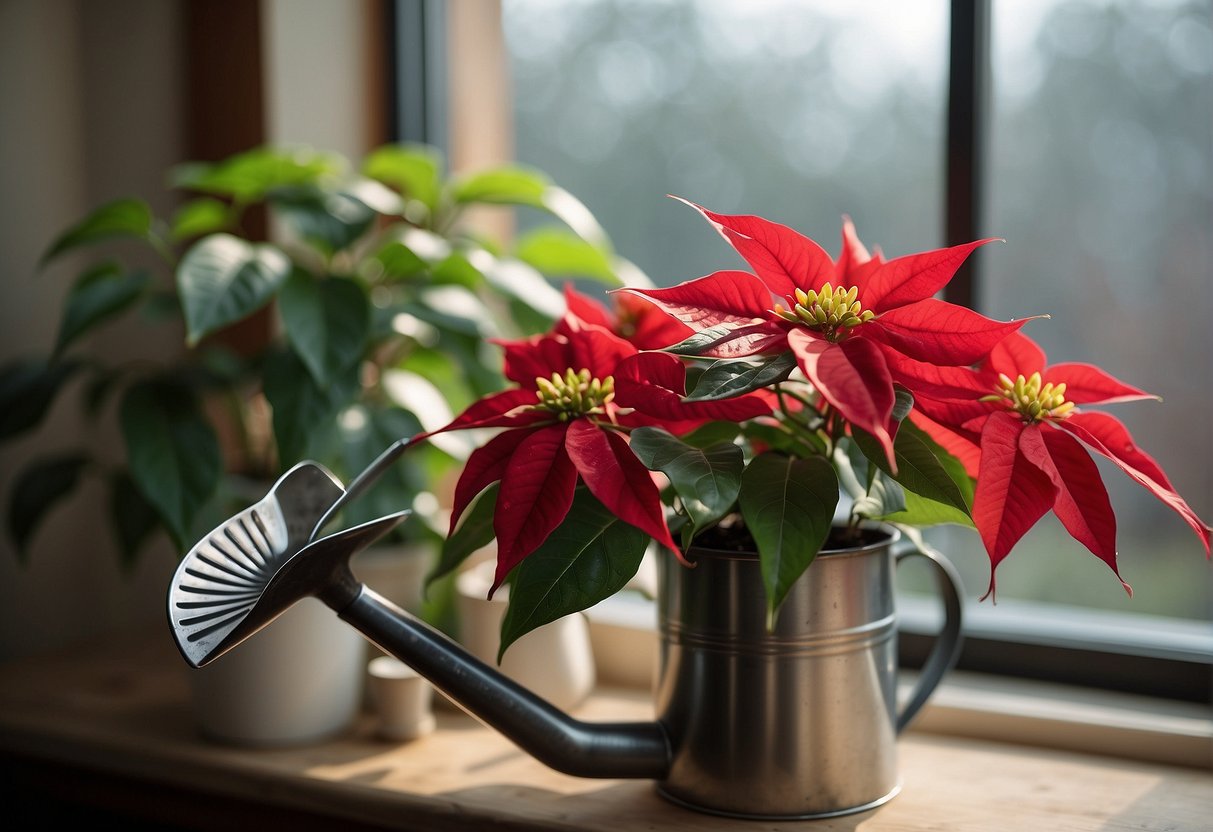
Poinsettias are generally easy to care for, but problems can arise from time to time. Here are some common issues that can occur and how to address them.
Dealing with Pests and Diseases
Pests and diseases can cause damage to poinsettias, affecting both their appearance and health. Mealybugs are one of the most common pests that can infest poinsettias. These small, white insects feed on the sap of the plant, causing wilting leaves and yellow foliage. To get rid of mealybugs, use a cotton swab dipped in rubbing alcohol to wipe them off the plant. Repeat this process until all the mealybugs are gone.
Another common problem is root rot, which is caused by overwatering. This can cause the foliage to wilt and turn yellow. To prevent root rot, make sure the soil is well-draining and never let the plant sit in standing water. If root rot has already set in, it may be necessary to repot the plant in fresh soil.
Addressing Environmental Stress
Poinsettias can also be affected by environmental stress, such as exposure to cold drafts or lack of sunlight. Cold drafts can cause the leaves to wilt and drop off. To prevent this, keep the plant away from cold windows or doors, and make sure it is not exposed to temperatures below 50°F.
Lack of sunlight can cause the plant to become leggy and weak. To prevent this, make sure the plant is placed in a bright, sunny location. If this is not possible, consider using artificial grow lights to supplement the natural light.
Overall, by keeping an eye out for pests and diseases, and ensuring the plant is in a suitable environment, you can keep your poinsettia healthy and looking its best throughout the holiday season.
Safety and Precautions

When it comes to keeping poinsettias alive, it is important to take some safety and precautionary measures. Poinsettias are known to be toxic to both dogs and cats, so it is essential to keep them out of reach of pets. The milky sap of the poinsettia plant contains chemicals that can cause irritation, vomiting, and diarrhea in pets if ingested.
In Central America, where poinsettias are native, they are known as Euphorbia pulcherrima. This plant belongs to the Euphorbia family, which is known for its milky sap. This sap can cause skin irritation and allergic reactions in humans. Therefore, it is recommended to wear gloves when handling poinsettias and to avoid touching your face or eyes after handling them.
It is also important to keep poinsettias away from children, as they may be tempted to touch or taste the plant. In case of accidental ingestion, it is recommended to call the Poison Control Center immediately.
To prevent any accidents, it is best to place poinsettias in a safe location, away from pets and children. Additionally, it is recommended to wrap the plant in plastic or paper when transporting it, to prevent any sap from leaking.
In summary, while poinsettias are a beautiful addition to any holiday decor, it is important to take safety and precautionary measures when handling them. By following these simple steps, you can enjoy your poinsettias without any worries.
Frequently Asked Questions
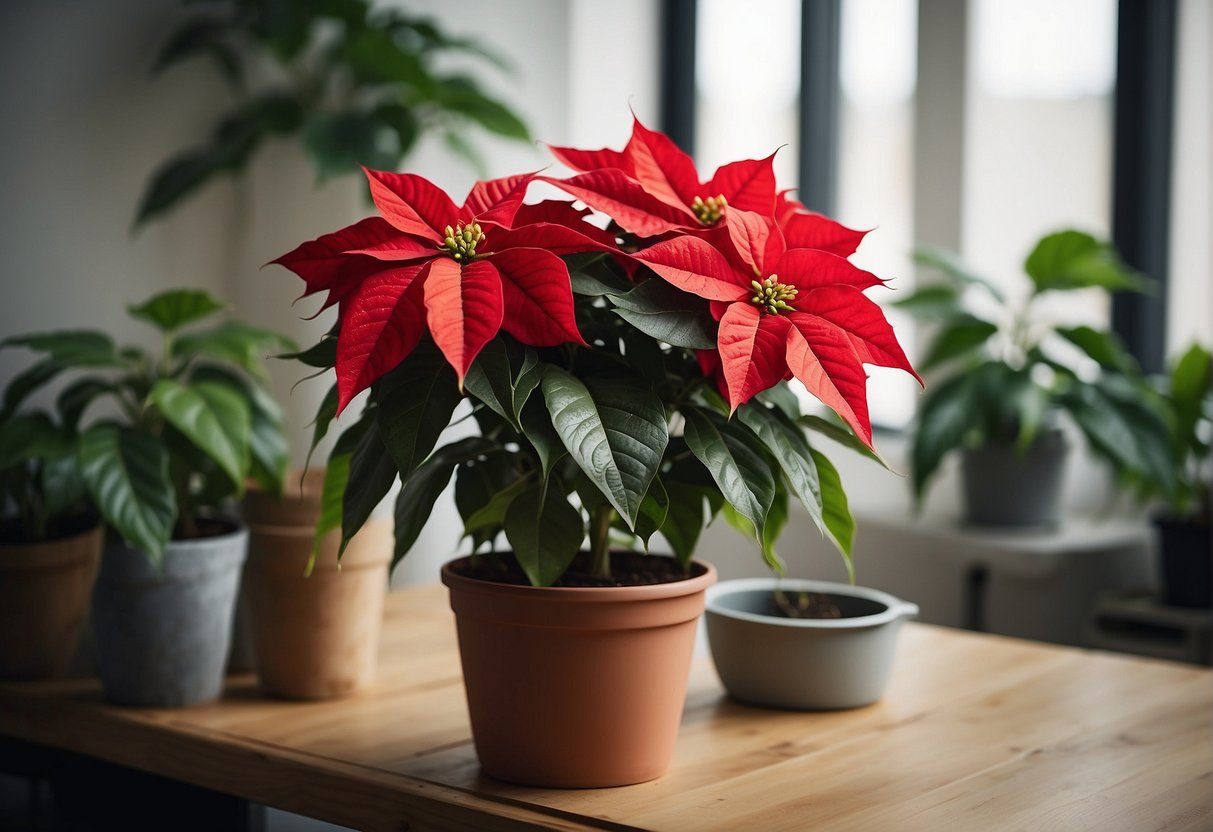
What is the ideal indoor care routine for poinsettias to thrive?
Poinsettias thrive in bright, indirect light and temperatures between 65-75°F. They should be placed in a room with good air circulation and away from drafts. Avoid placing them near heating vents or fireplaces as this can cause the leaves to dry out.
How often should poinsettias be watered to maintain proper moisture levels?
Poinsettias should be watered when the top inch of soil feels dry to the touch. It is important not to let the plant sit in standing water as this can cause root rot. It is recommended to use a pot with drainage holes and to empty any excess water from the saucer after watering.
What are the steps to ensure poinsettias retain their vibrant red color?
Poinsettias require a period of darkness for 14-16 hours per day for 6-8 weeks in order to develop their vibrant red color. After this period, they should be placed in bright, indirect light for the remainder of the day. It is also important to avoid exposing them to any artificial light during the period of darkness.
What conditions are necessary for a poinsettia to rebloom?
Poinsettias require a period of darkness for 14-16 hours per day for 6-8 weeks in order to rebloom. After this period, they should be placed in bright, indirect light for the remainder of the day. It is important to note that reblooming poinsettias can be difficult and may require specific growing conditions.
Can poinsettias be transitioned to outdoor environments, and if so, how?
Poinsettias can be transitioned to outdoor environments in the spring after the danger of frost has passed. They should be gradually acclimated to outdoor conditions by placing them in a shaded area for a few hours each day. It is important to avoid exposing them to direct sunlight as this can cause the leaves to burn.
When is the appropriate time to expose poinsettias to darkness for natural blooming?
The appropriate time to expose poinsettias to darkness for natural blooming is in the fall, around October 1st. This will allow for the necessary 14-16 hours of darkness per day for 6-8 weeks before the holiday season.

